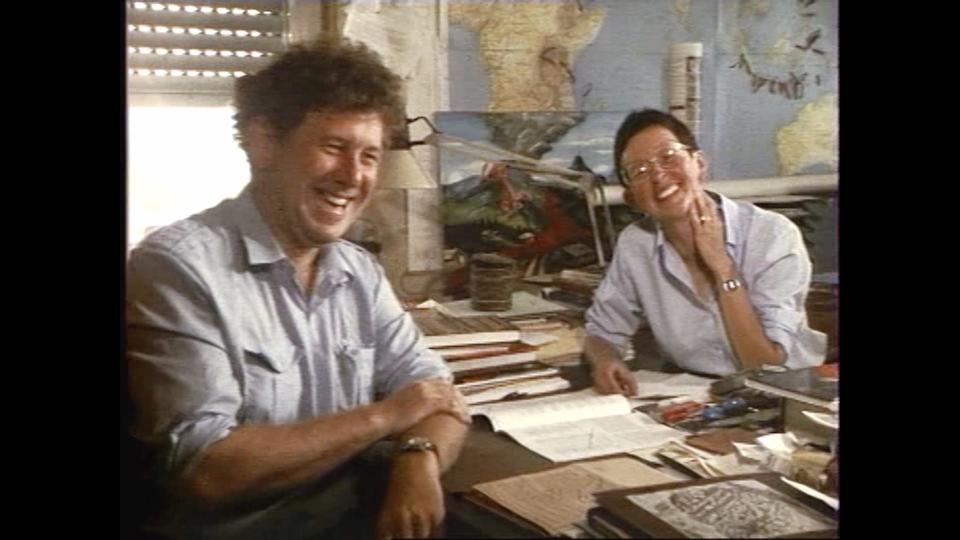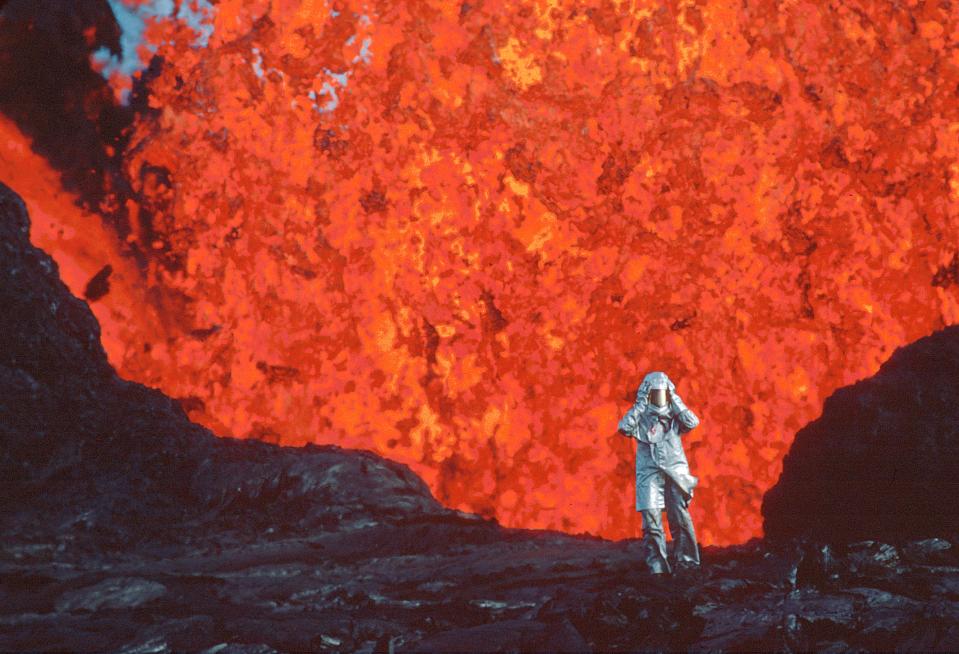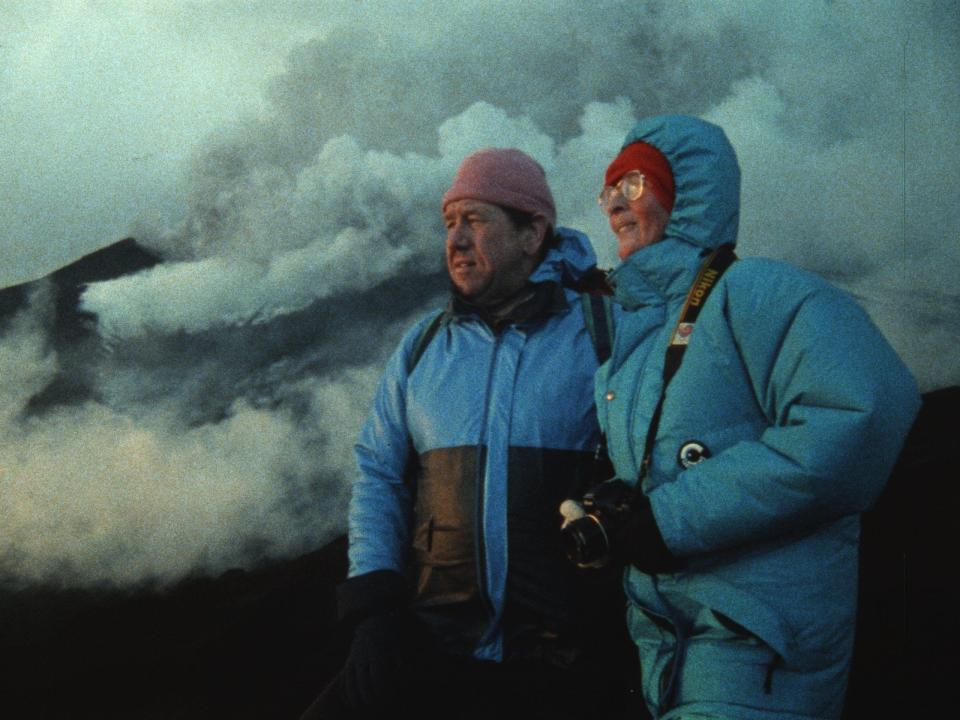They died together in a volcano blast. Now, their love story is an unlikely Valentine's Day film.
- Oops!Something went wrong.Please try again later.
- Oops!Something went wrong.Please try again later.
Lava cools red, sulfur burns blue. We like volcanoes – and love stories, too.
On Valentine's Day, Oscar-nominated documentary "Fire of Love" returns to theaters nationwide for one night only. The heart-tugging film (also streaming now on Hulu and Disney+) chronicles the daring research and romance of volcanologists Katia and Maurice Krafft, a married couple who died together in a volcanic eruption in 1991.
"For it to come out on Valentine's – a day where we celebrate love and the people we get to walk through (life) with – makes me particularly happy," filmmaker Sara Dosa says. "I think Katia and Maurice would be very amused."
Who were Katia and Maurice Krafft?

Maurice, 45, and Katia, 49, were French scientists who devoted their lives to studying volcanoes. After meeting at the University of Strasbourg in France, they married in 1970 and spent their honeymoon on the volcanic island of Stromboli, where they photographed almost continuous eruptions. Throughout their careers, they hiked to the edges of active volcanoes to collect data samples such as rocks and gases. They also captured footage to educate the public about the wonders and dangers of volcanic explosions.
"They were able to capture things that very few people had seen before," Dosa says. "For 30 years, they toured the world with their footage: putting on conferences, going on speaking tours and introducing people to the world of volcanoes. (They thought) if people could fall in love with volcanoes, that would engender a curiosity about our planet. And if one can fall in love with the planet, hopefully one can care for it, too."
'Fire of Love' uses their breathtaking footage of volcanoes

"Fire of Love" pulls from thousands of photographs and more than 200 hours of footage Katia and Maurice shot. Dosa discovered their work while researching another project and was transfixed by their passion for volcanoes and each other.
"They were so philosophical and playful – they just seemed like people we would love to get to know," Dosa says. "And then we found they had hundreds of hours of footage that they took of erupting volcanoes, and it was utterly spectacular. It was just like: 'Oh, yeah. There's an incredible story here.' "
For Maurice and Katia, encountering a force as powerful and dangerous as volcanoes was an almost "divine" experience. And in a strange way, it was also deeply romantic.
"They were building a relationship with the forces of creation and destruction, and seeking understanding of this seemingly unknowable force that was responsible for life on this planet," Dosa says. "When you're in touch with something so transcendent, it's profoundly alluring and hits at the essence of romance. There's an unrequitedness: You can long to to be in this transcendent state, all the while knowing you can never actually reach it."
The adventurous couple 'knew how to live with fear'
The National Geographic documentary illustrates just how risky their feats were. In one nail-biting scene, Maurice takes an inflatable raft out on a sulfuric acid lake in Indonesia but quickly abandons his mission as acid starts chewing through the boat. In another, Katia gets frighteningly close to an erupting volcano in Iceland without wearing a protective aluminized suit.
"She's just wearing a red parka," Dosa recalls. "Then she runs and puts on her suit, but there's pieces of lava splatting next to her and apparently, her thermometer read 1,200 degrees Celsius. But she was unflinchingly there – that was just absolutely stunning."
The dauntless pair always maintained a sense of mischief and humor, at one point frying eggs over the heat of volcanic rocks.
"They're such mythic characters," Dosa says. "They weren't fearless, but they knew how to live with fear and almost dance with it."
They died together trying to educate people

After the deadly eruptions of Mount St. Helens in Washington and Mount Pinatubo in the Philippines, Katia and Maurice devoted their time to teaching government officials about the importance of volcano warning systems and evacuation plans. It's part of the reason they traveled to Japan's erupting Mount Unzen in 1991 and tried to film its pyroclastic flows – a destructive, fast-moving mix of ash, rock and gases that runs down the slope of a volcano.
"Their mission was to communicate the hazards of volcanoes, which is what they were literally trying to do when they died," Dosa says. "They were trying to capture this one specific shot of a pyroclastic surge so they could educate governments on how to properly evacuate people."
The couple got caught in a pyroclastic flow and died, along with more than three dozen other people in the eruption. Their bodies were found side by side.
"I would love to know what they felt and if there was a moment of acceptance, like, 'OK, here it is,' " Dosa says. "They spent so much time talking about the possibility of their death and reconciling it. I hope there was a moment of peace, knowing that they lived their life truly with their utmost meaning and purpose."
More Oscar-nominated viewing options:
From 'Everything Everywhere' to 'Elvis': Here's where to stream these Oscar-nominated movies now
Donkeys are Oscar season's biggest stars: From 'Banshees' and 'Eo' to 'Triangle of Sadness'
'Women Talking': Rooney Mara says it was 'very easy' channeling new motherhood into role
Fact checking the new 'Elvis' movie: Did he really fire Colonel Tom Parker onstage in Las Vegas?
Why remake a 92-year-old Oscar-winning movie? 'All Quiet on the Western Front' director explains
This article originally appeared on USA TODAY: 'Fire of Love': Oscar-nominated movie back in theaters Valentine's Day

